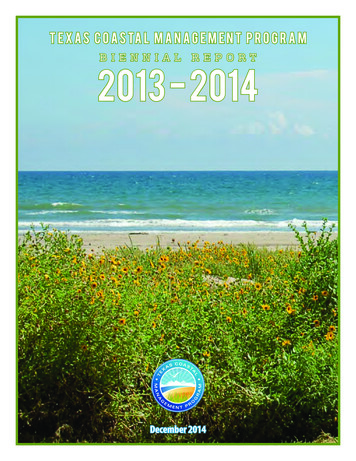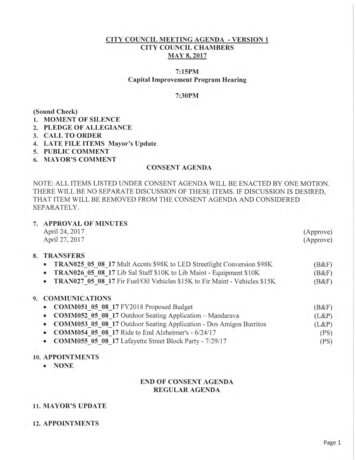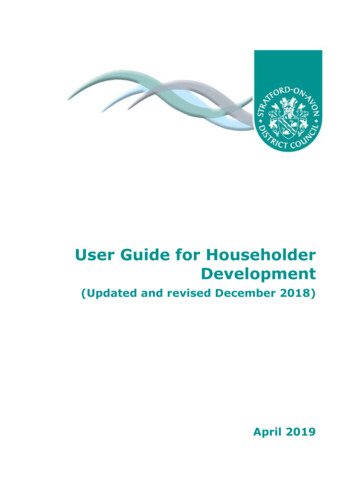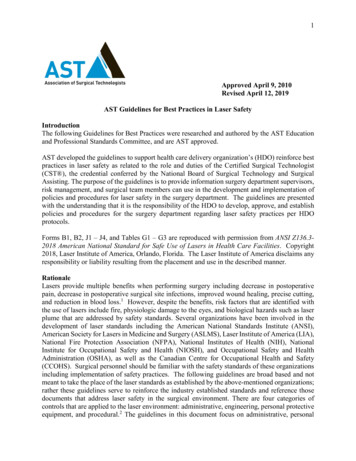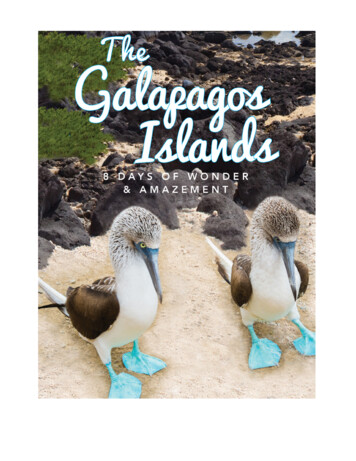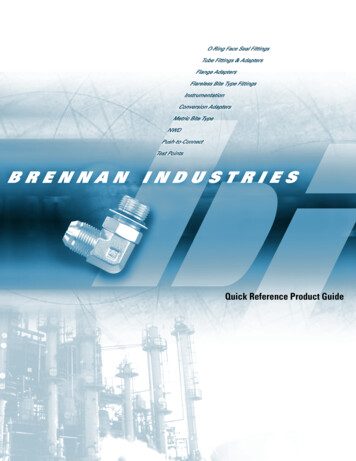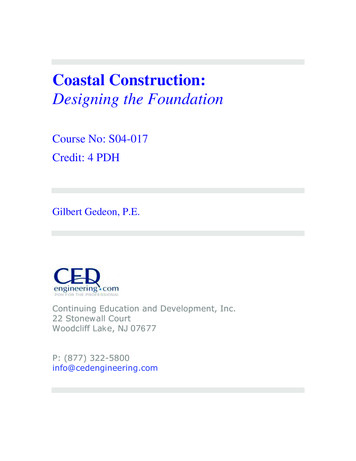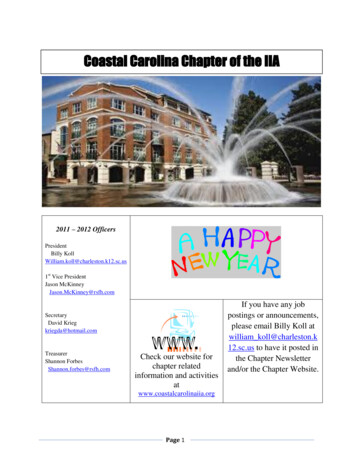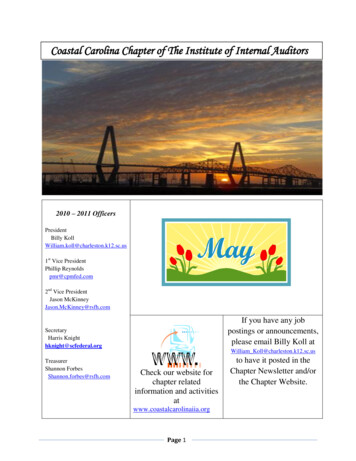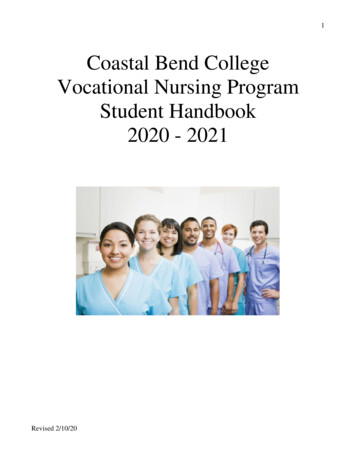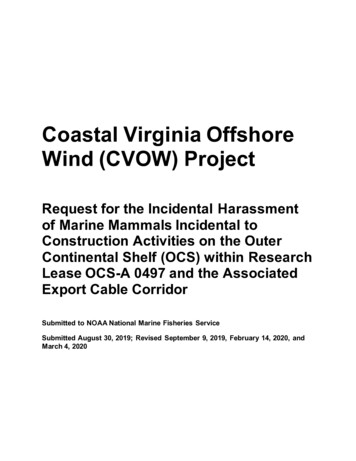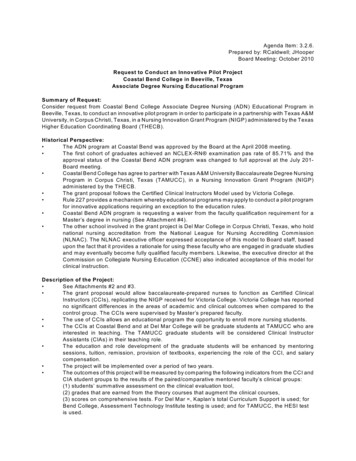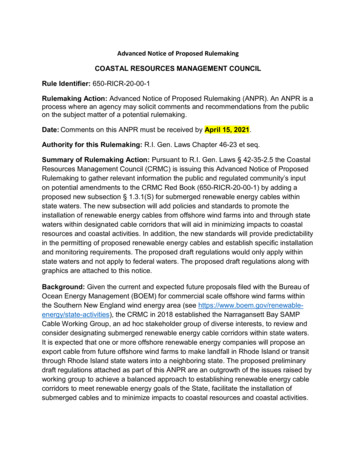
Transcription
Advanced Notice of Proposed RulemakingCOASTAL RESOURCES MANAGEMENT COUNCILRule Identifier: 650-RICR-20-00-1Rulemaking Action: Advanced Notice of Proposed Rulemaking (ANPR). An ANPR is aprocess where an agency may solicit comments and recommendations from the publicon the subject matter of a potential rulemaking.Date: Comments on this ANPR must be received by April 15, 2021.Authority for this Rulemaking: R.I. Gen. Laws Chapter 46-23 et seq.Summary of Rulemaking Action: Pursuant to R.I. Gen. Laws § 42-35-2.5 the CoastalResources Management Council (CRMC) is issuing this Advanced Notice of ProposedRulemaking to gather relevant information the public and regulated community’s inputon potential amendments to the CRMC Red Book (650-RICR-20-00-1) by adding aproposed new subsection § 1.3.1(S) for submerged renewable energy cables withinstate waters. The new subsection will add policies and standards to promote theinstallation of renewable energy cables from offshore wind farms into and through statewaters within designated cable corridors that will aid in minimizing impacts to coastalresources and coastal activities. In addition, the new standards will provide predictabilityin the permitting of proposed renewable energy cables and establish specific installationand monitoring requirements. The proposed draft regulations would only apply withinstate waters and not apply to federal waters. The proposed draft regulations along withgraphics are attached to this notice.Background: Given the current and expected future proposals filed with the Bureau ofOcean Energy Management (BOEM) for commercial scale offshore wind farms withinthe Southern New England wind energy area (see ies), the CRMC in 2018 established the Narragansett Bay SAMPCable Working Group, an ad hoc stakeholder group of diverse interests, to review andconsider designating submerged renewable energy cable corridors within state waters.It is expected that one or more offshore renewable energy companies will propose anexport cable from future offshore wind farms to make landfall in Rhode Island or transitthrough Rhode Island state waters into a neighboring state. The proposed preliminarydraft regulations attached as part of this ANPR are an outgrowth of the issues raised byworking group to achieve a balanced approach to establishing renewable energy cablecorridors to meet renewable energy goals of the State, facilitate the installation ofsubmerged cables and to minimize impacts to coastal resources and coastal activities.
The CRMC invites comment on the specific issues listed below, but will also considerother comments provided in writing during the 30-day comment period.1. Potential costs that could be incurred by applicants by requiring cable burial atthe specified depths or using specified technology within the rules. Are theremore cost-effective methods and will they achieve the industry specified cableburial depths necessary (4 to 6 feet) to minimize impacts to the environment,coastal resources and coastal users as well as protect the integrity of the cableitself?2. Are the monitoring provisions (e.g., fisheries and electromagnetic frequency)within the proposed rules sufficient to ensure that necessary information isprovided to the agency and the public to ensure that the regulatory standards areachieved? Are there less costly and more efficient methods to achieve thedesired monitoring information?3. It is expected that having a designated renewable cable corridor or corridorswould assist in state agency permitting reviews and provide predictability toapplicants and the public. Do the proposed rules provide sufficient flexibility andare there other methods for designating preferred cable corridors within statewaters, other than by the proposed rule adoption, that would be more efficient orbe less costly? Additionally, CRMC is soliciting comments on any likely marginalcosts or benefits concerning the Narraganset Bay West Passage, specificallyregarding location and width, that might impact future offshore wind developersor other stakeholders.4. This proposed rule sets out standards and process for designating Areas ofParticular Concern (APC) and CRMC expects future regulatory actions will codifythose exact areas consistent with the process specified in the CRMC’s OceanSAMP. Do the standards set out in the proposed rule, and the APCs that arelikely to be designated under these standards (e.g., shipwrecks), create anymarginal costs or benefits that should be considered?Additional Information and Comments:All interested parties are invited to submit written comments concerning the proposedamendment until April 15, 2021 by email or postal service with the CRMC staff personand address listed below:James BoydCoastal Resources Management CouncilStedman Government Center4808 Tower Hill RoadWakefield, RI 02879jboyd@crmc.ri.gov
Proposed/annotated amendmentsNote: This is an entirely new subsection and proposed new text is identified as blueunderline650-RICR-20-00-1.3.1(S)S.Submerged renewable energy cables within state waters1.Policiesa.The Council shall identify and designate a renewable energy cablecorridor or corridors within Rhode Island state waters for thepurpose of facilitating the installation of submerged renewableenergy cables from offshore wind farms and to minimize potentialadverse impacts to Rhode Island coastal resources and uses.b.The Council shall collaborate with and consider the advice andrecommendations of the CRMC’s Cable Working Group as part ofthe Narragansett Bay SAMP, which includes members of theCRMC Fishermen’s Advisory Board (FAB), as defined in § 0511.3(E) of this Chapter, representation of the RI Shellfisherman’sAssociation, RI Department of Environmental Management Divisionof Marine Fisheries (DEM DMF), and other interested stakeholders,to minimize, and when feasible eliminate, potential adverse impactsto Rhode Island coastal resources and uses.c.For purposes of this Part in designating a renewable energy cablecorridor or corridors, representation of commercial fishing interestsin state waters, including, but not limited to, the RI Shellfisherman’sAssociation, the RI Lobstermen’s Association, etc., shall beincluded on the CRMC’s Cable Working Group to aid the CRMC inidentifying areas of active fish, crustacean and shellfish harvestingwithin state waters and to advise and make recommendations tothe CRMC for the purpose of minimizing, and when feasibleeliminating, potential adverse impacts to sensitive and importantfish habitats and to the commercial fishing industry as a result ofsubmerged renewable energy cable installation and operationwithin state waters.d.It is the Council’s policy to identify and designate Areas ofParticular Concern (APCs) within state waters with the advice andrecommendations of the CRMC’s Cable Working Group for thepurposes of this Part. APCs shall include those areas as specifiedin § 05-11.10.2 of this Chapter. In addition, APCs shall includeareas of paleolandscapes that contain or have a high probability ofcontaining significant cultural artifacts as may be identified and
confirmed through appropriate sources including, but not limited to,the RI Historic Preservation and Heritage Commission.2.e.It is the Council’s policy to preserve submerged paleolandscapes,which are areas along the seafloor with a higher potential to containcultural and historical resources, within state waters. In addition, ifshipwrecks or possible shipwrecks have been identified within thecorridor, these should either be avoided or should be assessed todetermine if they are significant cultural resources eligible for listingin the National Register of Historic Places. When paleolandscapesare identified as likely containing significant cultural and historicalresources, the Council shall designate them as APCs.f.Given the current state of uncertainty in the magnitude of potentialimpacts to marine organisms from electromagnetic fields (EMF)associated with submerged electrical cables from offshore windfarms in southern New England offshore waters, the Council willestablish standards to require applicants to use appropriate cableburial methods and technology for the anticipated or discoveredconditions to achieve appropriate cable burial depths in an effort toavoid and minimize adverse EMF effects.g.Any submerged renewable energy cable approved by the CRMC,regardless of its location within state waters, shall be subject to anannual submerged lands fees specified by the CRMC andconsistent with R.I. Gen. Laws § 46-23-1(f) within any permit issuedby the CRMC or as may be required by any applicable legislativeaction.Standardsa.All submerged renewable energy cables in state waters shall beinstalled and maintained within a CRMC designated renewableenergy cable corridor(s) as shown in § 1.3.1(S)(5) of this Part,regardless of whether the cable makes landfall in Rhode Island oranother state.a.Renewable energy cables shall not be installed within the U.S.Department of Defense (DoD) restricted areas of Narragansett Bay,as specified in 33 CFR §§ 334.80, 334.81 and 334.82, without theexplicit authorization of the DoD and CRMC approval.c.Submerged renewable energy cables shall be presumptivelyexcluded from being installed within a CRMC designated APC. Thisexclusion is rebuttable if the applicant can demonstrate by clearand convincing evidence that there are no practicable alternativesthat are less damaging in areas outside of the APC, or that the
proposed project will not result in a significant alteration to thevalues and resources of the APC. When evaluating a projectproposal, the Council shall not consider cost as a factor whendetermining whether practicable alternatives exist. Applicants whichsuccessfully demonstrate that the presumptive exclusion does notapply to a proposed project because there are no practicablealternatives that are less damaging in areas outside of the APCmust also demonstrate that all feasible efforts have been made toavoid damage to APC resources and values This exclusion isrebuttable if the applicant can demonstrate by clear and convincingevidence that there are no practicable alternatives that are lessdamaging in areas outside of the APC, or that the proposed projectwill not result in a significant alteration to the values and resourcesof the APC. When evaluating a project proposal, the Council shallnot consider cost as a factor when determining whether practicablealternatives exist. Applicants which successfully demonstrate thatthe presumptive exclusion does not apply to a proposed projectbecause there are no practicable alternatives that are lessdamaging in areas outside of the APC must also demonstrate thatall feasible efforts have been made to avoid damage to APCresources and values. The Council may require a successfulapplicant to provide a mitigation plan that protects the ecosystem.d.Applications for submerged cables submitted to the CRMC shallinclude site plans showing the location of the proposed cable(s)within state tidal waters, the landfall location and proposed electricgrid connection point. In addition, design details and cableinstallation methods shall be provided for all proposed renewableenergy cables within state waters including the cable landfall andthe upland cable routes to the electric grid connection point. Thesite plans and detail sheets shall be certified and stamped by aprofessional engineer licensed by the state of Rhode Island.e.In the event that an applicant proposes an alternative locationwithin state waters for a renewable energy cable that is locatedpartially or wholly outside of a CRMC designated renewable energycable corridor, then the applicant must meet the variance criteria of§ 1.1.7 of this Part and provide scientifically valid assessments andevidence to the CRMC concerning the following conditions:(1)It is not feasible for the proposed renewable energy cable tobe located within a CRMC designated renewable energycable corridor due to existing conditions;(2)Maintaining the renewable energy cable entirely within aCRMC designated cable corridor is not feasible due to theproposed cable landfall location;
(3)The proposed alternative cable route will not have significantadverse impacts to Rhode Island coastal resources anduses; and(4)The proposed alternative if located within a CRMCdesignated APC meets the requirements of 1.3.1(S)(2)(c) ofthis Part.f.Applications for submerged cables within state waters shall meet allapplicable programmatic standards including, but not limited to, §§1.1.6(F), 1.3.1(A), 1.3.1(C), 1.3.1(H) and 1.3.1(I) of this Part.g.Submerged cable installation(1)The target burial depth for submerged cables proposed forinstallation on a seafloor bottom shall be 4 to 6 feet (1.2 to1.8 m) below the seafloor (BSF). The target cable burialdepths shall be determined through a cable burial risk (orfeasibility) assessment (CBRA) based on an assessment ofseabed conditions, seabed mobility, and the risk ofinteraction with external hazards such as commercial fishinggear and vessel anchors. Where sufficient burial depthcannot be achieved based on the CBRA, or protection isrequired due to cables crossing other cables or pipelines,additional cable protection methods may be used inaccordance with § 1.3.1(S)(2)(g)(4) of this Part.(2)In areas where submerged cable installation may bechallenging due to bedrock or other geologic obstruction, theapplicant must use appropriate cable burying technology andaccepted engineering techniques to achieve target cableburial depth as specified in § 1.3.1(S)(3)(g)(1) of this Part.Jet plow cable installation methods may not be suitable inareas of hard bottom (those containing rocks, cobble, excessclay and silt and other known geologic obstructions).(3)During cable burial, the target cable burial depth shall beachieved as soon as practical following cable laying withinthe trench to minimize the possibility of cable damage fromship anchors. Mariners shall be advised daily by theapplicant of cable laying operations through mariner bulletinson the appropriate VHF radio channel(s) in addition to twiceweekly email notifications to an established email notificationlist and following the U.S.C.G. regulations for notice tomariners.
(4)Secondary cable protection methods (e.g., concretemattresses, rock berms or rock bags) may have adverseimpacts on commercial fishing gear by creating obstructionsthat may snag and cause damage to mobile fishing gear(e.g., trawl nets) or fixed gear (e.g., lobster pots, fish potsand gill nets). Therefore, the applicant shall limit secondarycable protection to areas where the cable is insufficientlyprotected (presenting a risk to marine users and/or thecable), at crossings with other submerged cables or utilities,or other areas in which cable burial is not possible (e.g.,cable joints). In addition, any necessary secondary cableprotection shall be constructed of biologically-friendlymaterials (i.e., that allow epifaunal colonization) that mimicas closely as possible the existing surrounding habitat.(5)In the event that alternative cable routing is not possible anddisturbance will be unavoidable within preservedpaleolandscapes that are likely to contain cultural andhistorical resources the applicant will propose cableinstallation techniques that will minimize disturbance andimpact on the paleolandscapes after seeking input andadvice from the State Historic Preservation Office (SHPO)and the local Tribal Historic Preservation Office (THPO). TheCRMC may stipulate specific conditions as recommended bythe SHPO or THPO as part of the CRMC assent.(6)All submerged cables making landfall (onshore of the MLLWline) shall target a burial depth greater than or equal to three(3.0) meters BSF. This standard is best achieved by usinghorizontal directional drilling (HDD) techniques and may berequired by the CRMC. A variance to this standard may begranted where the applicant demonstrates through theCBRA that the cable landing area is composed of a stableseafloor and a shoreline (e.g., man-made) unlikely to suffersignificant beach loss and erosion from coastal storms.(7)A Certification Verification Agent (CVA) may be required bythe CRMC in accordance with § 1.3.1(H)(3) of this Part.(8)Following the completion of a submerged cable, includingthe landfall, the applicant shall develop a cable inspectionprogram and submit it to the CRMC and the CVA. The cableinspection program shall confirm the cable burial depth alongthe route and identify the need for any further remedial burialactivities and/or secondary cable protection. The CVA shallprovide the review report to the CRMC within 90 days ofcompletion.
(9)h.i.The CVA shall provide a post-installation report followingproject completion verifying that the submerged cable andlandfall installations were completed in accordance with theCRMC approved plans and specifications and any remedialactions pursuant to the CVA cable inspection program asmay be required in § 1.3.1(S)(2)(g)(8) of this Part.Submerged cable monitoring(1)The entire cable route within state waters shall be surveyedusing multi-beam bathymetry promptly following submergedcable installation and the placement of any secondary cableprotection (if necessary). The entire cable route within statewaters will again be surveyed following the first and secondyears of operation. The results of the post-lay, year 1 andyear 2 multi-beam cable surveys shall be provided to theCRMC review within forty-five (45) days of surveycompletion and include any remedial actions taken orscheduled to occur. The entire cable route within statewaters will continue to be surveyed for the lifecycle of theproject using multi-beam bathymetry every two (2) yearsfollowing completion of the year 2 survey and shall beprovided to the CRMC within forty-five (45) days of surveycompletion.(2)In the event that cable monitoring shows an installed cablehas been exposed or the cable presents a risk to othermarine users, or is at risk of being damaged, then theapplicant or successive permit holder shall promptly submit acorrective action report and receive approval from the CRMCbefore implementing corrective measures in compliance withthe CRMC permit and any order of the Council.Electromagnetic field (EMF) monitoring requirements(1)Applicants shall provide to the CRMC background EMFmeasurements along the area of the intended cable routewithin state waters prior to the installation of any submergedrenewable energy cable. Both alternating current (AC) anddirect current (DC) EMF measurements shall be conducted.(2)At the completion of installation and activation of anysubmerged renewable energy cable within state waters, theapplicant or successive permit holder shall monitor EMFlevels along the cable route at least once annually for theservice life of the cable and provide measurements to theCRMC with a location map of all measurement stations.
Measurement stations shall include cable portions thatachieved the target cable burial depth and cable portionsthat include secondary protection that did not meet targetcable burial depths.j.3.4.Submerged cable applications shall include a fisheries monitoringplan for state waters. The applicant shall consult with the RIDEMDivision of Marine Fisheries for the appropriate inclusion of species,gear methods and sampling protocols and obtain CRMC approvalof the fisheries monitoring plan. The applicant shall implement thefisheries monitoring plan to obtain the specified fisheries monitoringdata for a minimum of one full year prior to cable installation,through the entirety of the construction period, and for two (2) yearsfollowing commencement of cable activation and operation. Theapplicant’s fisheries monitoring plan may include data the state hasobtained as part of ongoing state monitoring activities as asupplement to the applicant required monitoring data.Standards for Areas of Particular Co
coastal resources and coastal users as well as protect the integrity of the cable itself? 2. Are the monitoring provisions (e.g., fisheries and electromagnetic frequency) within the proposed rules sufficient to ensure that necessary information is provided to the agency and the pub
